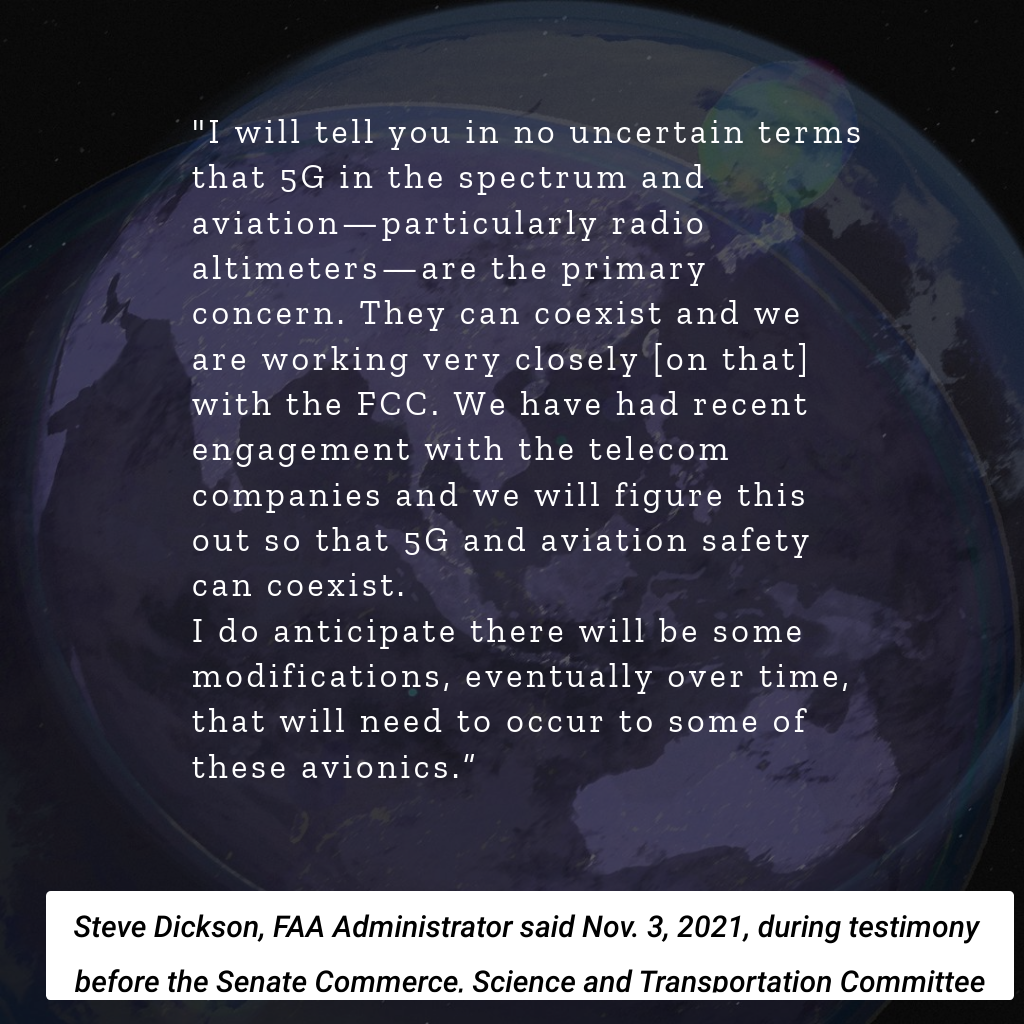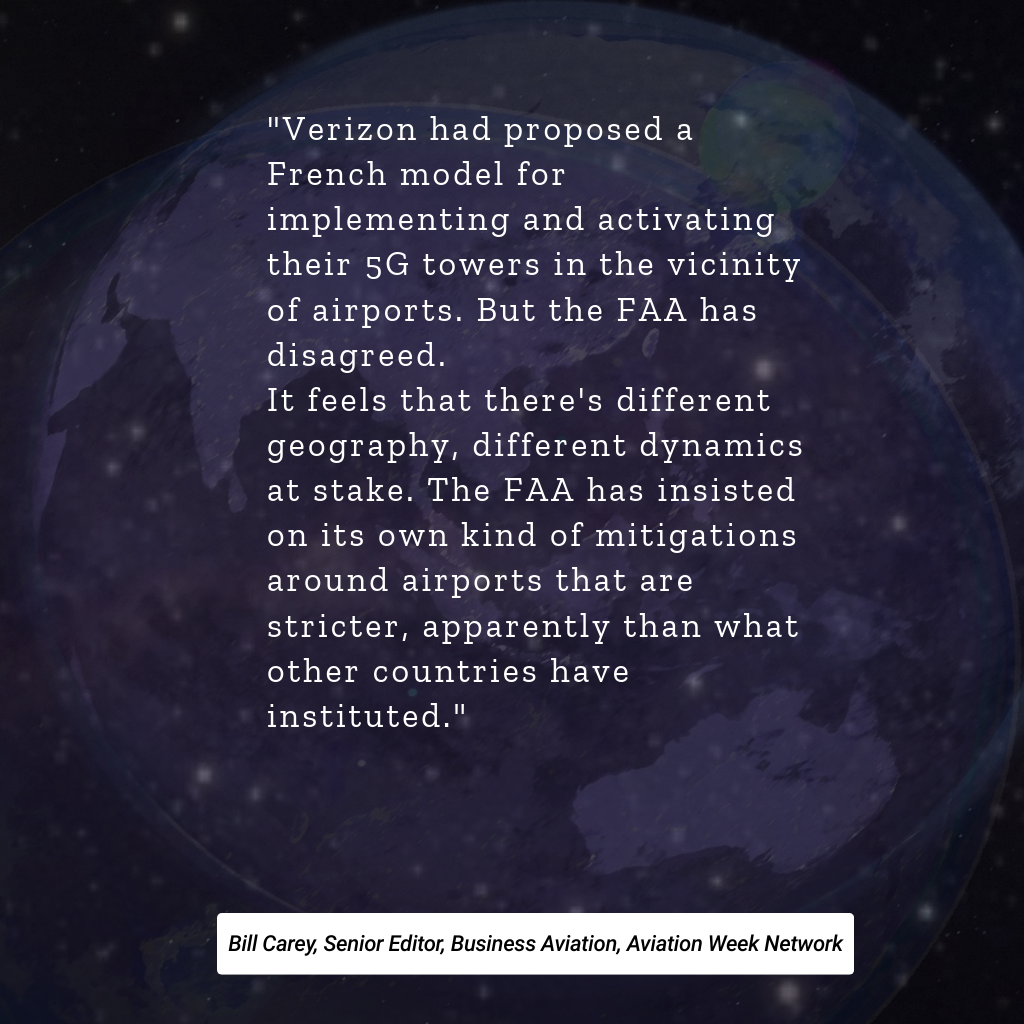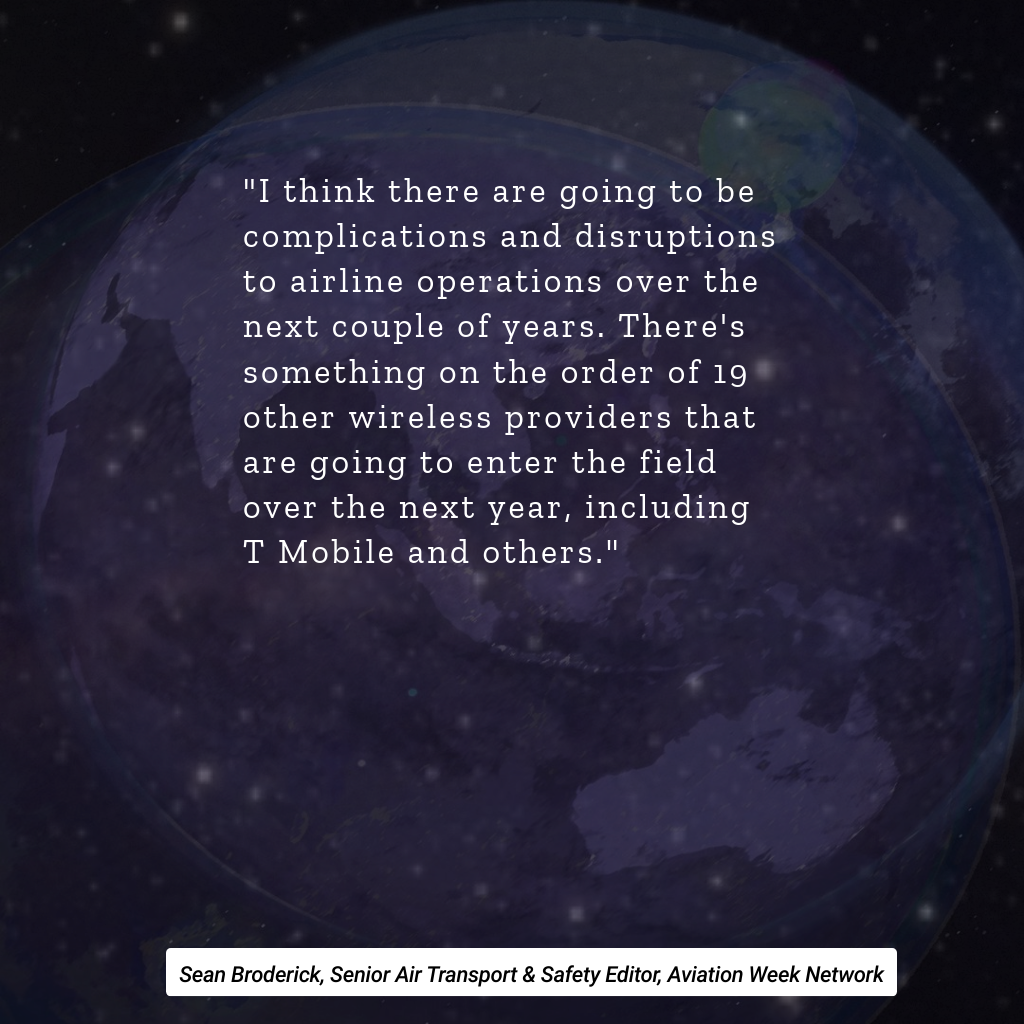5G: What You Need to Know
August 29, 2022
What is 5G?
5G is the 5th generation mobile network and wireless standard after 1G, 2G, 3G, and 4G networks.
5G is a new wireless network using the C-band frequency spectrum between 3.7-3.98 GHz (3700-3980 MHz). For more information read the Checklist: Understanding The 5G Interference Issue, published January 6, 2022.

Why is the FAA and aviation industry concerned about 5G?
The FAA is concerned with safety. On November 2, 2021, the FAA issued a Special Airworthiness Information Bulletin (SAIB) alerting aviation manufacturers, operators and pilots to the potential adverse effects of new 5G wireless networks on radio altimeters.
The FAA's approval process for radio altimeters, which is based on Technical Standard Order TSO-C87A, does not provide criteria for compatibility with adjacent-band operations, including potential impacts associated with wireless broadband networks.
Read more in the article FAA Warns Of 5G Effects On Radio Altimeters published on November 3, 2021.

What are radio altimeters?
Radio altimeters, also called radar altimeters, track an aircraft’s altitude over terrain by measuring reflected signals from about 2,500 ft. above ground level, operating between 4200-4400 MHz.
Credit Freeflight Systems
How might 5G affect aircraft radio altimeters?
In October 2020, RTCA (Radio Technical Commission for Aeronautics' special committee) SC-239 released the results of an evaluation it conducted of radio altimeter performance in the presence of radio frequency interference from future 5G networks operating in the 3.7-3.98 GHz band.
The study revealed “a major risk that 5G telecommunications” operating in the band “will cause harmful interference to radar altimeters on all types of civil aircraft—including commercial transport airplanes; business, regional, and general aviation airplanes; and both transport and general aviation helicopters.” Read more in the article FAA Warns Of 5G Effects On Radio Altimeters published on November 3, 2021.
Credit: NBAA

What came before 5G?
The second generation of mobile networks, 2G, was launched in 1991 as the Global System for Mobile (GSM) Communications. At first, GSM’s main innovation was to turn analog signals into digital, decreasing distortion, improving transmission distances, and allowing for more information to be transferred more quickly. It also introduced text messages. The second innovation was to use information packets.
2G expanded into previously unused frequencies, as high as 1,900 MHz. Higher frequencies could carry more data but had shorter ranges, necessitating more cell towers. By the end of the 2G era, speeds of 40,000 bits per second (40 kbps) and higher were achieved. Read more in an article about what came before 5G published February 3 2022.
Credit: Shutterstock

What other concerns are there?
Regional jets are particularly vulnerable to interference from 5G C-band signals, leaving some concerned they may not have access to certain airports as new wireless services roll out.
A handshake agreement between the FAA and telecommunications companies to phase in new 5G C-band wireless networks near airports over the next year has many aviation industry stakeholders concerned that they will not be able to meet the agency’s targets.
The agreement, announced by the FAA in mid-June, “will continue to enable aviation and 5G C-band wireless to safely coexist” as wireless companies steadily expand their services through July 2023, FAA Acting Administrator Billy Nolen said. It calls for operators to modify their aircraft to protect radio altimeters, or radalts, based on a schedule that factors in wireless companies’ plans to expand services around airports. Read more in the article published August 8, 2022. Credit: Sean Broderick/AW&ST

What is the situation regarding helicopters and business aviation?
The rotorcraft industry obtained a limited exemption from the FAA allowing air ambulance helicopters to continue operating when planned FAA flight restrictions linked to new 5G wireless services force came into force.
The Helicopter Association International (HAI) and other aviation organizations reacted to the FAA's release of nearly 1,500 Notices To Air Missions (NOTAMS) restricting flight operations near 5G cellular towers that AT&T and Verizon activated in January 2022. The telecom companies in early January agreed with the FAA for a second time to postpone the launch of their new C-band 5G networks over concern that wireless transmissions could interfere with aircraft radio altimeters.
John Shea, HAI’s director of government affairs, said the association received notice from the FAA that the agency has partially approved a petition for exemption it had filed that will allow air ambulance helicopters operating under Part 135 and Part 91 regulations to fly in the vicinity of 5G tower sites.
He said: "While all operations were not exempt from the restrictions, the mitigations that we described in the petition were granted because they maintain an equivalent level of safety... [The exemption] “will provide helicopter air ambulances the opportunity to operate in NOTAM’ed airspace, the ability to use night-vision goggles and unimproved landing sites where NOTAMs are identified to [prevent] problems with an unreliable radio altimeter.” Read the full article published January 14, 2022.
Credit: Helicopter Association International
The wireless carriers volunteered to limit their 5G service activations until July 5, 2022, while working with the FAA to better understand the effects of 5G C-band signals on radio altimeters operating at nearby frequencies.
The wireless companies have been working with the FAA to better understand the effects of 5G C-band signals on radio altimeters operating at nearby frequencies.
But following a series of meetings involving the aviation and telecommunications industries, wireless carriers AT&T and Verizon agreed to a phased approach that allows them to activate 5G services using C-band spectrum near some airports where the risk of interference and disruption of flight schedules is considered minimal while keeping in place voluntary limitations elsewhere until July 2023.
This extension will give airlines more time to replace or protect radio altimeters from potential interference, the FAA said in response. Read the full article, Wireless Companies Agree To Extend 5G Limitations, published on June 17.
Credit: Patrick T. Fallon/AFP via Getty Images

Other countries such as Brazil, Canada, France, Thailand have been able to implement their 5G network deployments. Is the U.S. being difficult?
AWN senior editor business aviation Bill Carey was a panelist in a Window Seat podcast. He said that the FAA has insisted on its own kind of mitigations around airports. Check out the Podcast: FAA's 5G Dilemma published on August 4, 2022.

Can the 5G issue be resolved any time soon?
AWN air transport and safety editor Sean Broderick was a panelist in a Window Seat podcast. He said that he felt that the 5G issue is far from close to being resolved. Tune in to the Podcast FAA's 5G Dilemma published August 4, 2022.

What is 5G?
5G is the 5th generation mobile network and wireless standard after 1G, 2G, 3G, and 4G networks.
5G is a new wireless network using the C-band frequency spectrum between 3.7-3.98 GHz (3700-3980 MHz). For more information read the Checklist: Understanding The 5G Interference Issue, published January 6, 2022.

Why is the FAA and aviation industry concerned about 5G?
The FAA is concerned with safety. On November 2, 2021, the FAA issued a Special Airworthiness Information Bulletin (SAIB) alerting aviation manufacturers, operators and pilots to the potential adverse effects of new 5G wireless networks on radio altimeters.
The FAA's approval process for radio altimeters, which is based on Technical Standard Order TSO-C87A, does not provide criteria for compatibility with adjacent-band operations, including potential impacts associated with wireless broadband networks.
Read more in the article FAA Warns Of 5G Effects On Radio Altimeters published on November 3, 2021.

What are radio altimeters?
Radio altimeters, also called radar altimeters, track an aircraft’s altitude over terrain by measuring reflected signals from about 2,500 ft. above ground level, operating between 4200-4400 MHz.
Credit Freeflight Systems
How might 5G affect aircraft radio altimeters?
In October 2020, RTCA (Radio Technical Commission for Aeronautics' special committee) SC-239 released the results of an evaluation it conducted of radio altimeter performance in the presence of radio frequency interference from future 5G networks operating in the 3.7-3.98 GHz band.
The study revealed “a major risk that 5G telecommunications” operating in the band “will cause harmful interference to radar altimeters on all types of civil aircraft—including commercial transport airplanes; business, regional, and general aviation airplanes; and both transport and general aviation helicopters.” Read more in the article FAA Warns Of 5G Effects On Radio Altimeters published on November 3, 2021.
Credit: NBAA

What came before 5G?
The second generation of mobile networks, 2G, was launched in 1991 as the Global System for Mobile (GSM) Communications. At first, GSM’s main innovation was to turn analog signals into digital, decreasing distortion, improving transmission distances, and allowing for more information to be transferred more quickly. It also introduced text messages. The second innovation was to use information packets.
2G expanded into previously unused frequencies, as high as 1,900 MHz. Higher frequencies could carry more data but had shorter ranges, necessitating more cell towers. By the end of the 2G era, speeds of 40,000 bits per second (40 kbps) and higher were achieved. Read more in an article about what came before 5G published February 3 2022.
Credit: Shutterstock

What other concerns are there?
Regional jets are particularly vulnerable to interference from 5G C-band signals, leaving some concerned they may not have access to certain airports as new wireless services roll out.
A handshake agreement between the FAA and telecommunications companies to phase in new 5G C-band wireless networks near airports over the next year has many aviation industry stakeholders concerned that they will not be able to meet the agency’s targets.
The agreement, announced by the FAA in mid-June, “will continue to enable aviation and 5G C-band wireless to safely coexist” as wireless companies steadily expand their services through July 2023, FAA Acting Administrator Billy Nolen said. It calls for operators to modify their aircraft to protect radio altimeters, or radalts, based on a schedule that factors in wireless companies’ plans to expand services around airports. Read more in the article published August 8, 2022. Credit: Sean Broderick/AW&ST

What is the situation regarding helicopters and business aviation?
The rotorcraft industry obtained a limited exemption from the FAA allowing air ambulance helicopters to continue operating when planned FAA flight restrictions linked to new 5G wireless services force came into force.
The Helicopter Association International (HAI) and other aviation organizations reacted to the FAA's release of nearly 1,500 Notices To Air Missions (NOTAMS) restricting flight operations near 5G cellular towers that AT&T and Verizon activated in January 2022. The telecom companies in early January agreed with the FAA for a second time to postpone the launch of their new C-band 5G networks over concern that wireless transmissions could interfere with aircraft radio altimeters.
John Shea, HAI’s director of government affairs, said the association received notice from the FAA that the agency has partially approved a petition for exemption it had filed that will allow air ambulance helicopters operating under Part 135 and Part 91 regulations to fly in the vicinity of 5G tower sites.
He said: "While all operations were not exempt from the restrictions, the mitigations that we described in the petition were granted because they maintain an equivalent level of safety... [The exemption] “will provide helicopter air ambulances the opportunity to operate in NOTAM’ed airspace, the ability to use night-vision goggles and unimproved landing sites where NOTAMs are identified to [prevent] problems with an unreliable radio altimeter.” Read the full article published January 14, 2022.
Credit: Helicopter Association International
The wireless carriers volunteered to limit their 5G service activations until July 5, 2022, while working with the FAA to better understand the effects of 5G C-band signals on radio altimeters operating at nearby frequencies.
The wireless companies have been working with the FAA to better understand the effects of 5G C-band signals on radio altimeters operating at nearby frequencies.
But following a series of meetings involving the aviation and telecommunications industries, wireless carriers AT&T and Verizon agreed to a phased approach that allows them to activate 5G services using C-band spectrum near some airports where the risk of interference and disruption of flight schedules is considered minimal while keeping in place voluntary limitations elsewhere until July 2023.
This extension will give airlines more time to replace or protect radio altimeters from potential interference, the FAA said in response. Read the full article, Wireless Companies Agree To Extend 5G Limitations, published on June 17.
Credit: Patrick T. Fallon/AFP via Getty Images

Other countries such as Brazil, Canada, France, Thailand have been able to implement their 5G network deployments. Is the U.S. being difficult?
AWN senior editor business aviation Bill Carey was a panelist in a Window Seat podcast. He said that the FAA has insisted on its own kind of mitigations around airports. Check out the Podcast: FAA's 5G Dilemma published on August 4, 2022.

Can the 5G issue be resolved any time soon?
AWN air transport and safety editor Sean Broderick was a panelist in a Window Seat podcast. He said that he felt that the 5G issue is far from close to being resolved. Tune in to the Podcast FAA's 5G Dilemma published August 4, 2022.
Most people have a smartphone these days and it will likely either be a 4G or 5G handset, but who really knows what to make of the current 5G versus radio altimeter frequency clash in the U.S. and the safety impact it may have on aviation?
Here we unravel some of the complexities.









